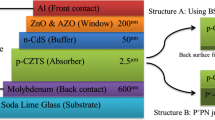Abstract
The carrier recombination was one of the factors limiting the further improvement of the Cu2ZnSnS4 (CZTS) thin film solar cells. In this paper, a proper bandgap structure was designed to solve this problem. The effects of the different bandgap structure on the CZTS thin film solar cells were studied by the solar cell performance simulation software wxAMPS. A graded bandgap structure was designed and optimized. The bandgap with a front bandgap gradient and a flat bandgap gradient had a favorable effect on the CZTS thin film solar cells. Finally, the fill factor (FF) and conversion efficiency (η) of the CZTS thin film solar cell were increased from 36.41% to 42.73% and from 6.85% to 10.03%, respectively. In addition, the effect of donor and acceptor defect densities in CZTS absorber layer near the CdS/CZTS interface on the device performance was studied, η of the CZTS thin film solar cell was increased from 5.99% to 7.55% when the acceptor defect concentration was 1012–1013 cm−3. Moreover, the thicknesses of the CZTS absorber layer were optimized. The FF and η of the CZTS thin film solar cell were increased to 63.41% and 15.04%, respectively.
Similar content being viewed by others
References
Aydin R and Akyuz I, Optik 200, 163407 (2020).
Fernandes P A, Salomé P M P and Cunha A F, Thin Solid Films 517, 2519 (2019).
Naoufel K, Chamekh S and Kanzari M, Sol. Energy 207, 496 (2020).
Babichuk I S, Semenmenko M O and Caballero R, Sol. Energy 205, 154 (2020).
Xu J T, Yang J and Jiang S X, Ceram. Int. 46, 25927 (2020).
Wang W, Winkler M T, Gunawan O, Gokmen T, Todorov T K, Zhu Y and Mitzi D B, Adv. Energy Mater. 4, 1301465 (2014).
Wang J, Yu N and Zhang Y, J. Alloys Compd. 688, 923 (2016).
Yoshida S, Solar Frontier Achieves World Record Thin-Film Solar Cell Efficiency of 23.35%, Int. Conf. Prop. Steam, 2 (2019).
Cherouana A and Labbani R, Appl. Surf. Sci. 424, 251 (2017).
Tchognia J H N, Arba Y, Dakhsi K, Hartiti B, Ridah A, Ndjaka J M and Thevenin P, Optimization of the Output Parameters in Kesterite-Based Solar Cells by AMPS-1D, In Proceedings of the 3rd International Renewable and Sustainable Energy Conference (IRSEC), 1 (2015).
Maykel C, Valencia-Resendiz E, Pulgarín-Agudelo F A and Vigil-Galán O, Solid-State Electron. 118, 1 (2016).
Mohammadnejad S and Parashkouh A B, Appl. Phys. A: Mater. Sci. Process. 123, 758 (2017).
Ferhati H and Djeffal F, Opt. Mater. 76, 393 (2018).
Amiri S, Dehghani S and Safaiee R, Opt. Quantum Electron. 52, 323 (2020).
Arbouz H, Aissat A and Vilpot J P, Int. J. Hydrogen Energy. 42, 8827 (2017).
Mostefaoui M, Mazari H and Khelifi S, Energy Procedia. 74, 736 (2015).
Adewoyin A D, Olopade M A and Chendo M, Opt. Quantum Electron. 49, 336 (2017).
Jinqun S, Haiyan Q, Zhiyao M and Xuemei Z A, J. Huazhong Univ. Sci. Technol. 29, 24 (2016). (in Chinese)
Neamen D A, The Physics of Semiconductors, 7th ed, Enke L, Jinsheng L, Publishing House of Electronics Industry: Beijing, China, 155 (2011).
Cetinkaya S, Optik 181, 627 (2019).
Author information
Authors and Affiliations
Corresponding authors
Additional information
This work has been supported by the National Natural Science Foundation of China (No.61804108).
Rights and permissions
About this article
Cite this article
Wang, Y., Wang, J., Li, H. et al. wxAMPS theoretical study of the bandgap structure of CZTS thin film to improve the device performance. Optoelectron. Lett. 17, 475–481 (2021). https://doi.org/10.1007/s11801-021-0159-6
Received:
Revised:
Published:
Issue Date:
DOI: https://doi.org/10.1007/s11801-021-0159-6




